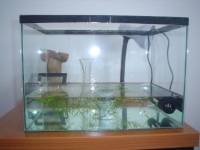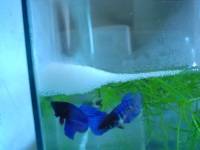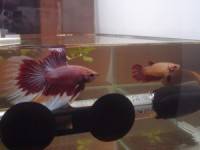Betta Fish (Betta splendens) – The Complete Care, Breeding, and Tank Setup Guide
Quick links
What This Guide Covers
This comprehensive guide to Betta splendens—also known as Siamese fighting fish—explains how to care for these iconic fish from setup to breeding. Inside, you'll find expert tips on tank requirements, compatible species, feeding, diseases, breeding, and fry care. Whether you’re a first-time owner or a breeder looking to improve results, this article provides clear and practical information for every stage of a Betta’s life.
🐠 1. Introduction: The Royal Fish of Home Aquariums – Betta splendens
Betta splendens, commonly known as the Siamese fighting fish, is one of the most popular freshwater species in the aquarium hobby. Their striking colors, elegant fins, and unique personalities make them a favorite among aquarists of all experience levels—from beginners to seasoned breeders.
Originally native to Asia, Bettas thrive in shallow, slow-moving waters such as rice paddies, streams, and ponds rich in vegetation. Thanks to their labyrinth organ, they are able to breathe atmospheric oxygen—an adaptation that helps them survive in poorly oxygenated environments. However, this does not mean that a small bowl without a filter or plants is a suitable long-term habitat!
Today, Bettas are available in hundreds of color morphs and fin types, with males generally more colorful and flamboyant than females. While they are beautiful and hardy, they still require proper care, tank setup, and an understanding of their territorial behavior—especially if kept with other fish.
This comprehensive guide will walk you through everything you need to know about caring for Siamese fighting fish, including tank setup, diet, breeding, fry care, compatible tank mates, and disease prevention.
🖼️ Photo Gallery: The Beauty of Betta splendens
🔍 2. Appearance and Sexing
Betta fish are widely admired for their vibrant coloration and graceful fin shapes, but telling males and females apart can sometimes be tricky—especially when the fish are still young. Understanding the visual differences between the sexes is essential for proper care, especially if you plan to breed them or house more than one in the same tank.
Male vs. Female: Fins, Color, Size
Male Bettas are typically the showstoppers in the aquarium world. They have:
- Long, flowing fins (especially in selectively bred varieties)
- Bright, saturated colors—reds, blues, greens, purples, and more
- More aggressive behavior, particularly toward other males
Female Bettas, while less flamboyant, have their own beauty and charm. They tend to have:
- Shorter, more rounded fins
- Subtler or duller coloration (though selective breeding has made many females quite colorful)
- Plumper body, especially around the belly when gravid (carrying eggs)
- A visible ovipositor—a small white dot near the ventral area, used for laying eggs
Young Bettas: Common Mistakes
Sexing juvenile Bettas (under 3 months old) can be unreliable. Many aquarists mistakenly purchase what they think are females, only to discover weeks later that their "female" was actually a male with developing fins and color.
If you're unsure about the sex of a Betta, it's best to wait until the fish matures before attempting to pair or house them with others. Rushing into group setups too soon can result in unexpected aggression or stress-related illness.
In juvenile groups, mild flaring and short chases are common. One interesting behavior observed is the “headstand”—a submissive posture where a younger or weaker male tilts head-down to show non-aggression. This often defuses tension, allowing both fish to part without further conflict.
Visual Comparison
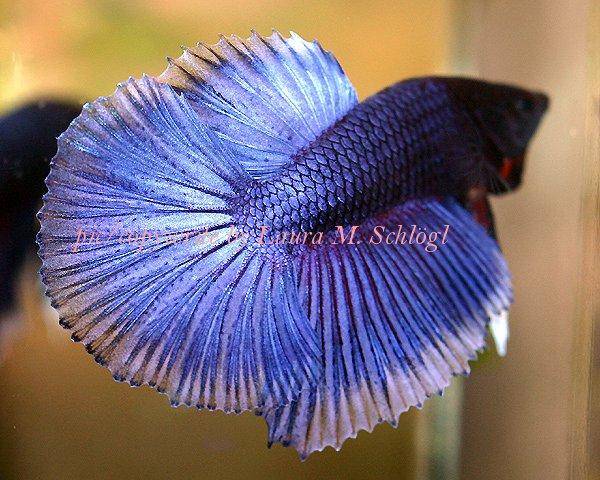
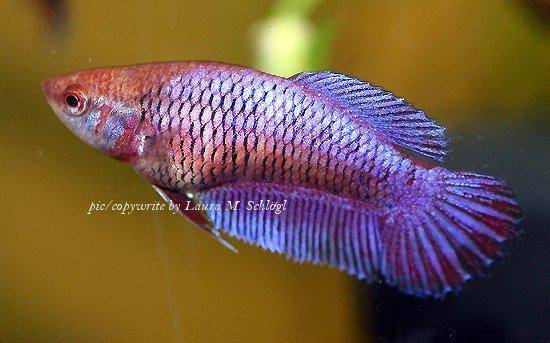
🌈 3. Color and Fin Variants
Thanks to decades of selective breeding, Betta splendens are available in a dazzling array of colors, patterns, and fin shapes. These variations make Bettas not only beautiful but also highly collectible among hobbyists.
Color Variants
Betta fish colors can be grouped into several main categories:
- Solid color: The entire body and fins are one uniform color. Common examples include:
- White
- Black
- Red
- Blue
- Turquoise
- Yellow
- Orange
- Green
- Cellophane (almost transparent)
- Bi-color: The body and fins are distinctly different colors. Popular bi-color types include:
- Cambodian: Pale body with red or blue fins
- Chocolate: Dark brown body with creamy or light-colored fins
- Multicolor: Multiple colors appear without a specific pattern. These Bettas are the most common in pet stores.
- Patterned: Recognizable patterns across the body and fins:
- Marble: Irregular blotches that change over time
- Butterfly: Solid body with fins that are split into two or more bands of color
- Piedball: Light-colored face regardless of body color
Fin Types
While both sexes can exhibit various colors, only males typically display elaborate fin types. These include:
- Veil Tail (VT): The most common fin type with a long, flowing downward-curved tail.
- Delta and Super Delta: The tail spreads out in a triangular shape. Super Delta can approach 120° in spread.
- Halfmoon (HM): The tail forms a perfect 180° semicircle—very striking and sought after.
- Double Tail (DT): A tail that is clearly split into two lobes. This trait can also affect dorsal fin shape.
- Crown Tail (CT): The rays of the fins extend beyond the webbing, creating a spiky “crown” effect.
- Plakat (PK): A short-finned Betta resembling wild types, often more energetic and hardy.
Each type brings its own flair to the tank, but also may come with different care needs—especially for long-finned varieties that are more prone to fin damage.
⚔️ 4. Behavior and Aggression
Betta splendens are also known as Siamese fighting fish—and for good reason. These stunning fish are notorious for their intra-species aggression, especially among males. Understanding their natural behavior is essential for responsible fishkeeping and preventing injury or stress.
Intra-Species Aggression
Male Bettas are highly territorial. When placed in the same tank, they will almost always flare, fight, and attempt to injure—or even kill—each other. This instinctive behavior is hardwired from their wild ancestors who defend small territories in rice paddies and ponds.
But aggression isn’t limited to males. Females can be aggressive too, especially when establishing a hierarchy in a sorority group. Males may also chase or harass females, especially if they are not ready to spawn.
Housing Recommendations
- Never house two males together in the same tank.
- A single male with 2–3 females can sometimes work in a well-planted, spacious tank with plenty of hiding spots. However, careful observation is required.
- Keeping a female-only group (called a sorority) is possible in larger tanks (minimum 20–30 gallons) with at least 4–6 females. Odd numbers help reduce bullying.
Introducing Bettas to tank mates should always be done with caution. Each fish has its own personality, and even two females may not always get along. Providing visual barriers, caves, plants, and ample space can help reduce aggression.
When to Separate Bettas
You should
- Torn fins or visible injuries
- One fish constantly chasing or cornering another
- Loss of color, stress stripes, or hiding behavior
- Bubble nests being destroyed or guarded aggressively outside of breeding context
Using breeder boxes, tank dividers, or temporary isolation tanks can help during introductions or recovery. Long-term peace often depends on the individual temperament of each Betta and the tank’s design.
🏡 5. Suitable Aquarium for Betta Fish
5.1 Standard Tanks (10 Liters)
Contrary to popular belief, Betta fish should not be kept in tiny bowls or vases. A proper Betta setup starts with a standard aquarium of at least 10 liters (2.6 US gallons), although 15–20 liters (4–5 gallons) or more is highly recommended for optimal health and happiness.
Tank Size, Height, Lid, and Temperature Stability
- Tank height: Bettas are labyrinth fish, meaning they breathe surface air. A shallow tank (under 30 cm / 12 inches) helps them reach the surface with ease, especially as they age.
- Lid or cover: A lid keeps the air above the water warm and humid, which is important for the Betta’s labyrinth organ. It also prevents jumping.
- Stable temperature: Ideal temperature range is 25–28°C (77–82°F). Use an adjustable aquarium heater to avoid fluctuations, especially in colder climates or during winter.
Plants, Decorations, and Hiding Places
Live or silk plants are highly recommended. They help maintain water quality and provide shelter:
- Floating plants: Such as Pistia stratiotes or Lemna minor, offer shade and help reduce stress.
- Broad-leaved plants: Like Microsorum pteropus or Cryptocoryne affinis give Bettas places to rest near the surface.
- Hardscape: Add rocks, driftwood, or clay caves—but ensure all decorations have smooth edges to avoid tearing the Betta’s delicate fins.
Substrate and Water Flow
- Substrate: Fine gravel or sand is ideal. Avoid sharp substrates that may cause injuries.
- Water flow: Bettas prefer calm waters. Use a filter with an adjustable flow and set it to a gentle output. Strong current can stress the fish and interfere with bubble nest building.
Creating a comfortable and naturalistic environment reduces stress and enhances the Betta’s coloration, behavior, and longevity. A well-planned aquarium is key to a thriving Betta!
🟥 5.2 “Betta Fish Bowls” – Why Not!
Although fish bowls and brandy-glass-shaped tanks may look stylish or convenient, they are unsuitable environments for Betta fish in nearly every way. Sadly, these containers are often marketed specifically for Bettas due to their small size and the myth that Bettas can “live in a cup.”
Major Issues with Traditional Bowls
- Insufficient volume: Most bowls hold less than 5 liters (1.3 US gallons), which makes it impossible to maintain stable water parameters—temperature, ammonia, and pH fluctuate quickly in such small volumes.
- Unnatural shape: Round or spherical tanks create distorted reflections and can confuse fish, sometimes causing stress-related behaviors such as glass surfing or obsessive circular swimming.
- No space for equipment: Bowls rarely accommodate essential devices like heaters, filters, or lights. Without these, water quality and temperature become unpredictable—major stressors for Bettas.
- Maintenance burden: Frequent water changes are required to prevent toxic buildup, but this often causes further stress. It’s difficult to clean bowls thoroughly without disturbing the fish.
Mental and Physical Health Impact
Life in a bowl means limited swimming space, no stimulation, and exposure to fluctuating conditions. Over time, this leads to boredom, stress, fin rot, and a weakened immune system. Bettas kept in bowls generally have a much shorter lifespan and poorer quality of life than those in proper aquariums.
Exception: Designer Spherical Aquariums (100 Liters)
There is one exception worth mentioning. Some large, designer spherical aquariums with volumes of 100 liters (26 gallons) or more do exist. These models are usually equipped with built-in filters, lighting, and heating systems, making them fully functional despite their shape. However, they come at a premium price—often $500 or more—and are mostly purchased for aesthetic or display purposes.
Unless you're investing in such a high-capacity system, it’s best to avoid “Betta bowls” entirely. Your fish deserves more than just a pretty container—it deserves a habitat where it can truly thrive.
💧 6. Water, Lighting, and Plants
Creating a healthy aquatic environment for Betta fish requires more than just a tank and water—it’s about balancing temperature, chemistry, light, and plant life to mimic their natural habitat and promote long-term well-being.
Water Parameters
- Temperature: The ideal range is 27–28°C (80–82°F). Bettas are tropical fish and prefer consistently warm water. Sudden drops can weaken their immune system.
- pH level: Bettas thrive in slightly acidic to neutral water. Aim for a pH of 6.5 to 7.5. Stability is more important than perfection—avoid sudden shifts.
- Water hardness: Bettas are adaptable, but a general hardness (dGH) between 4–15°N is ideal. Carbonate hardness (KH) around 5–6 helps stabilize pH.
Water Changes
Even with a filter, regular water changes are essential to remove waste, uneaten food, and toxins such as ammonia and nitrates.
- Change 25–30% of the water weekly in a filtered tank.
- Use a dechlorinator and match the new water’s temperature to avoid shocking your Betta.
- Clean substrate gently and avoid over-cleaning filter media to preserve beneficial bacteria.
Lighting
Bettas prefer low to medium lighting. Intense light can stress them and encourage algae growth.
- Use a soft LED or fluorescent light for 6–10 hours a day.
- A day-night cycle helps regulate the fish’s behavior and improves plant health.
Recommended Aquarium Plants
Plants not only beautify the tank but also improve water quality and give Bettas places to explore and rest. Here are some great options:
- Cabomba caroliniana – Fine-leaved, fast-growing plant that oxygenates water well.
- Pistia stratiotes – A floating plant that provides shade and helps reduce stress.
- Vesicularia dubyana (Java moss) – Great for breeding tanks and fry hiding spots.
- Rotala nanjenshan – A light-loving stem plant that adds texture to the aquascape.
- Vallisneria torta – Ribbon-like leaves, great for background planting and oxygenation.
- Vallisneria asiatica – Compact, curly-leaved plant ideal for nano tanks or midground areas.
- Synnema triflorum – A rare aquatic plant with trailing stems and lush appearance.
- Hygrophila salicifolia – Fast-growing, narrow-leaved plant perfect for vertical structure.
- Microsorium pteropus (Java fern) – Hardy plant that attaches to rocks and driftwood.
- Hygrophila difformis (Water wisteria) – Great for nutrient uptake and sheltering fry.
- Cryptocoryne affinis – Shade-tolerant rosette plant ideal for foreground or midground.
- Ceratopteris thalictroides (Water sprite) – Delicate foliage, ideal for fry and reducing nitrates.
- Crinum thaianum – Bulb plant with long, flowing leaves suitable for large aquariums.
- Cyperus helferi – Grass-like plant that sways in the current, excellent for background use.
- Blyxa aubertii – Bushy, grass-like plant that adds volume and complexity to aquascapes.
A planted aquarium with the right light and water quality not only enhances the Betta’s health and color but also makes maintenance easier and more enjoyable.
🐟 7. Compatibility – Tank Mates for Betta Fish
Despite being known as “Siamese Fighting Fish,” Bettas can coexist peacefully with certain other species—if the tank is well-planned. The key is choosing the right tank mates and avoiding species that may provoke aggression or cause stress.
Recommended Tank Mates
These species are peaceful, slow-moving, or bottom-dwellers that usually don't disturb Bettas:
- Corydoras – Peaceful bottom feeders that mind their own business.
- Dwarf rasboras – Calm, small fish that swim in the upper and middle levels.
- Kuhli loaches – Shy, eel-like fish that stay near the substrate.
- Dwarf gouramis – Generally docile, especially in larger tanks.
- Zebra loaches – Gentle and helpful with cleaning uneaten food.
- Indawgyi stream catfish – Rare bottom dweller with a peaceful nature.
- Mottled loach – Quiet fish that prefers soft substrate and shade.
- Horseface loach – Timid burrower that rarely causes trouble.
- Badis – Small, slow-moving and usually non-aggressive.
- Burmese badis – Peaceful and colorful nano-sized companion.
- Badis blosyrus – Calm and reclusive species suited for planted tanks.
- Burmese loach – Active but non-aggressive bottom-dweller.
- Banded gourami – Generally calm, especially in low-stress setups.
- Yoma danio – Moderate swimmer that doesn’t compete for territory.
- Giant moth catfish – Nocturnal and peaceful, stays hidden during the day.
Tank Mates to Avoid
These species often cause problems due to their speed, aggression, or fin-nipping behavior:
- Guppies – Their bright colors and flowing tails can trigger aggression in male Bettas.
- Barbs – Known fin-nippers, especially Tiger Barbs.
- Fast tetras – Such as Serpae or Buenos Aires tetras, often chase or nip Bettas.
Factors That Influence Compatibility
- Tank size: A cramped aquarium leads to territorial disputes. Larger tanks (at least 40 liters / 10 gallons) with multiple hiding spots reduce aggression.
- Number of fish: A single Betta with a small group of peaceful species works better than overcrowding.
- Hiding places: Plants, driftwood, and caves allow all fish to claim their space and de-stress when needed.
Every Betta has a unique personality—some are calm, others are extremely territorial. Always observe new tank dynamics closely and be ready to separate fish if aggression appears.
🍽️ 8. Feeding Adult Betta Fish
Feeding your Betta properly is essential for its vibrant color, strong immune system, and long life. While Bettas aren’t picky eaters, a thoughtful diet helps prevent digestive issues and supports reproductive health.
Preferred Foods
- Live and frozen food: Brine shrimp (Artemia salina) and bloodworms are top choices. These mimic their natural prey and are highly nutritious.
- Flake food: Suitable for daily feeding if high in protein and designed for carnivorous fish.
- Pellets and granules: Choose ones formulated for Bettas or mid-sized cichlids. Avoid overfeeding with sinking pellets.
How to Feed Correctly
- Feed a small portion once a day, or slightly more every other day.
- Observe the fish during feeding: If the Betta spits the food out repeatedly, it may be too large—crush pellets or flakes into smaller bits.
- Always remove uneaten food after a few minutes to prevent water contamination.
Fasting Day
Once a week, allow your Betta to fast. A “rest day” gives its digestive system time to reset and reduces the risk of constipation and swim bladder issues. Don’t worry—healthy Bettas tolerate short fasting periods well.
With a balanced feeding routine and variety in diet, your Betta will stay healthy, active, and brilliantly colored.
🐣 9. Breeding Betta Fish – A Practical Guide
9.1 Choosing the Breeding Pair
Select healthy, young fish around 4–6 months old. Males should have vibrant coloration and undamaged fins. Females should have a rounded belly and visible ovipositor (white spot near the vent). Avoid using tired, injured, or overly old fish.
9.2 Breeding Tank Setup
- Volume: 15–20 liters (4–5 gallons)
- Water depth: 10–15 cm (4–6 inches) to reduce stress on the male when retrieving falling eggs
- Temperature: 27–28°C (80–82°F)
- Lid or cover: Maintains warm, humid air above water—essential for fry developing their labyrinth organ, which begins to form around day 30. Without a lid, sudden temperature shifts in the air can cause high mortality during this sensitive stage.
- Equipment: Heater, sponge filter (switched off during spawning), floating plants, hiding places for female (e.g., java moss, plastic plants). If live floating plants are unavailable, you can use a simple solution: a clean polystyrene cup cut in half and floated on the surface. This provides shelter for the bubble nest and helps mimic natural leaf cover.
9.3 Introducing the Pair
Place the male in the breeding tank first. Keep the female in a jar or breeding box within sight but separated. Visual contact stimulates bubble nest building. Introduce the female the next morning or once the nest is ready.
9.4 Mating Process
The male courts the female and wraps his body around her during spawning. Eggs are externally fertilized, then the male collects them and places them into the bubble nest. Minor fin damage is normal during this phase. If no spawning occurs within 3 days, separate and recondition both fish.
9.5 Egg and Fry Care
The male protects the nest and tends to the eggs. After 2–3 days, the fry hatch but remain in the nest. After another 2–3 days, they begin swimming freely. At this point, remove the male to prevent him from eating the fry.
⚠️ Important: Always keep the tank tightly covered during fry development. Sudden drops in air temperature can cause respiratory failure. The fry’s labyrinth organ is extremely sensitive in the first month, and breathing cold air can lead to fatal pneumonia.
Although males guard the nest diligently, they may begin eating the fry once they start swimming freely—especially if they feel stressed or crowded. To prevent this, remove the male 2–3 days after hatching, or as soon as fry become active.
9.6 Feeding the Fry
Fry should be fed live foods only for the first few weeks. Best options include:
- Newly hatched brine shrimp (Artemia)
- Infusoria or vinegar eels (for very small fry)
- Microworms (as an alternative)
Avoid dry or powdered food in the early days—fry rely on movement to recognize food.
9.7 Fry Development and Growth
Keep water clean using gentle daily changes with a syringe or soft tube. At 2 weeks, install a sponge filter and slowly transition to frozen/micropellets. After 4–6 weeks, separate aggressive juveniles, especially males, and move them into larger tanks. Early signs of aggression include chasing, fin nipping, and flaring.
🔹 BONUS: 10 Tips for a Successful Betta Breeding
- Use a shallow 15–20L tank with a lid to maintain warm, stable conditions
- Keep water temperature at 28°C (82°F) and provide subdued lighting
- Feed both fish high-quality live or frozen food for a week before breeding
- Introduce the male first, then the female on the following day
- Watch for bubble nest building as a sign the male is ready
- Add floating and hiding plants for comfort and nest stability
- Optionally, spill a small amount of oak cortex extract into the water to help stimulate spawning
- Remove the female immediately after spawning to avoid aggression
- Take the male out once fry start swimming freely (2–3 days post-hatch)
- Feed fry live food (e.g., Artemia) and begin separating aggressive juveniles around week 5
💡 Tip: Oak cortex extract isn’t mandatory, but it can help mimic natural blackwater conditions and encourage spawning behavior.
🚨 10. Diseases and Treatment
Betta fish are generally hardy, but poor water quality, stress, and injuries can lead to illness. Early detection and proper treatment are key to saving your fish. Below are the most common diseases and how to treat them.
Common Betta Diseases
- Injuries: Torn fins or body wounds caused by decorations or aggressive tankmates. Minor injuries heal on their own in clean water; for severe cases, use methylene blue or Mercurochrome in a quarantine tank.
- Fin and Tail Rot: Caused by bacterial infection. Symptoms: shredded fins, exposed rays, red or bloody fin bases. Treat with antibiotics, maintain pH near 6.0, and ensure pristine water quality.
- Ich (White Spot Disease): Parasite causing white dots, rapid breathing, and lethargy. Raise temperature to 28°C (82°F), add malachite green, and treat both quarantine and main tank.
- Swim Bladder Disorder: Betta floats on the surface or sinks and struggles to swim. Usually caused by overfeeding or bacterial infection. Fast the fish for a day, feed shelled peas or daphnia, and lower water depth if necessary.
- Ammonia Poisoning: Caused by poor filtration, overcrowding, or overfeeding. Symptoms: gasping at the surface, red gills, clamped fins. Perform 50% water changes for several days, use activated carbon in the filter, and test ammonia/nitrite levels.
Effective Treatments
- Methylene Blue: Prevents and treats bacterial, fungal, and protozoan infections. Best used in a quarantine tank.
- Malachite Green: Effective for external parasites and Ich.
- Salt Baths: Add ½ teaspoon of aquarium salt per gallon for 15–30 minutes. Useful for skin and scale issues.
- Formalin: Strong treatment for external parasites. Use cautiously (1–4 ml per 3 gallons), and only in well-ventilated areas.
- Garlic: A natural antibacterial. Soak food in garlic juice or feed finely chopped garlic for a few days.
How to Build a Betta First-Aid Kit
- A small quarantine tank (3–5 gallons)
- Aquarium heater and thermometer
- Sponge filter or air stone with pump
- Dedicated net for sick fish
- Methylene blue and malachite green
- Aquarium salt
- Activated carbon (for post-treatment)
- Water test kits (ammonia, nitrite, nitrate, pH)
Always remove invertebrates (like snails or shrimp) from tanks before treating with medication. After treatment, perform partial water changes and use activated carbon to remove residues.
🛡️ 11. Disease Prevention
Preventing illness is always easier and less stressful than treating sick fish. By maintaining proper tank conditions and establishing good care routines, you can ensure that your Betta fish stays healthy and vibrant.
Maintain Excellent Water Quality
- Regular water changes: Replace 25–30% of the water weekly to remove waste and toxins.
- Stable temperature: Keep water at 26–28°C (78–82°F); avoid sudden drops or fluctuations.
- Effective filtration: Use a gentle sponge filter or low-flow filter to maintain water clarity without stressing your Betta.
- Monitor parameters: Test pH, ammonia, nitrite, and nitrate levels regularly. Ideal pH is 6.5–7.5.
Smart Feeding and Stocking
- Feed properly: Avoid overfeeding—small portions once per day, with one fasting day per week, is ideal.
- Avoid overcrowding: Bettas prefer calm spaces. Do not house them with too many tankmates or in undersized tanks.
- Quarantine new fish: Keep new additions in a separate tank for 2–3 weeks to avoid spreading potential infections.
Provide a Comfortable Habitat
- Add hiding places: Caves, driftwood, and dense plant clusters help reduce stress and aggression.
- Use live plants: They help maintain water quality and mimic natural environments.
- Keep it peaceful: Do not house Bettas with fin-nipping or fast, aggressive species.
Prevention starts with consistency and observation. If your Betta’s behavior changes, test the water and take action early. A stable, peaceful, and well-maintained aquarium is the best defense against disease.
❓ 12. Frequently Asked Questions (FAQ)
Why is my Betta fish lying at the bottom of the tank?
This may indicate poor water quality, illness, or simply rest. Check ammonia, nitrite, and nitrate levels, and ensure the temperature is stable. Bettas sometimes rest on leaves or the substrate.
Why is my Betta losing its color?
Fading colors are often a sign of stress. Possible causes include water quality issues, sudden environmental changes, aggressive tankmates, or disease. Test the water and observe behavior closely.
How can I tell if my Betta is male or female?
Males usually have long, flowing fins and brighter colors. Females are smaller, with shorter fins and a rounder belly. At around 3–4 months of age, the differences become easier to spot. Young Bettas may be difficult to sex accurately.
When is the right age for Betta fish to breed?
Most Bettas become sexually mature at 3–5 months of age. Breeding is most successful before 12 months, when both fish are healthy and active.
How should I introduce a new Betta to my tank?
Float the sealed bag in the tank for 15–20 minutes to equalize temperature. Gradually add small amounts of tank water to the bag over another 15–30 minutes before gently releasing the fish into the tank.
What should I do after my Bettas spawn?
Once spawning is complete and the male has placed the eggs in the bubble nest, remove the female to prevent aggression. Leave the male to care for the eggs. After the fry begin free-swimming (2–3 days post-hatching), remove the male as well.
What is “Betta water”?
Some pet stores sell bottled water marketed for Bettas. It's usually dechlorinated and pH-balanced. However, regular tap water treated with a water conditioner is perfectly suitable for Bettas.
Why is my male Betta making bubbles without a female?
It’s a good sign! Bettas blow bubble nests when they feel comfortable and healthy. It’s not necessary for a female to be present—nest-building is part of their natural behavior.
What happens if my Betta eats too much?
Overfeeding can cause bloating and swim bladder issues. Stick to a small portion once per day, with one fasting day per week. If the fish spits out food, try crushing it into smaller pieces.



























